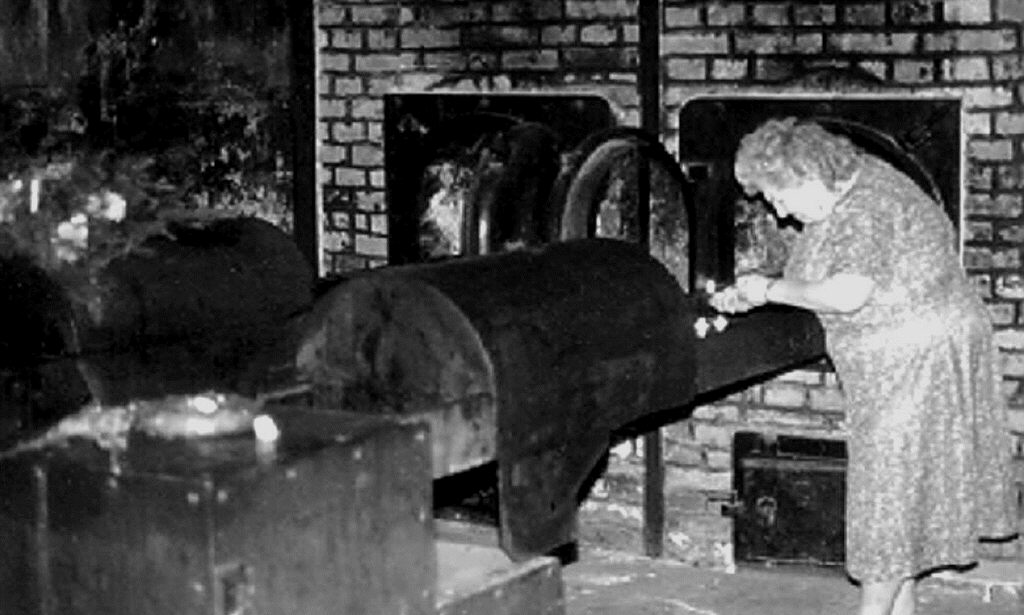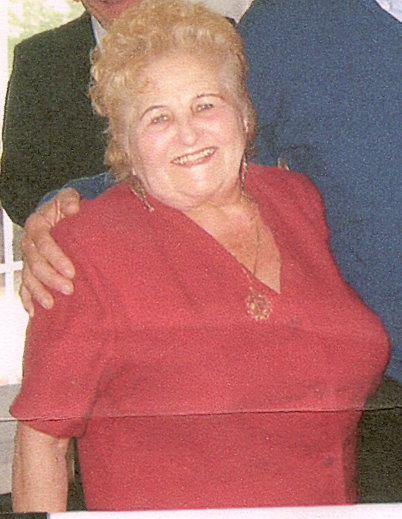Via Winston Smith Ministry of Truth

Holocaust survivor™ Frida Herskovits lights a candle at one of the ovens used to burn victims of the Holyhoax at the Auschwitz concentration camp in Poland. She went back to visit the site in 1994.
Frida Herskovits is a Jew born in Czechoslovakia in 1927.
In 1944 when she was 17, the Holocaust™ began and Frida was taken by the Nazis to a brick factory.
She says she had to sleep on the floor on top of the bricks.
Herskovits also worked with rocks or picking cabbage in a field.
Frida says she saw German shepherds "tear a baby out of the mother's wound"[sic!], witnessed the Germans shoot a baby, and saw people burned alive.
She says if you got sick the Nazis put you in a ditch, poured gasoline over you and set you on fire.
Frida even learned of experimental Nazi surgeries where "organs were removed and human skin was used to make lampshades and picture frames."
Frida tells her Holocaust tale to high school students to encourage people to "stop hating."

Article: "Holocaust survivor tells of concentration camps"
Note: use http://www.archive.org/ to find article if original link no longer works
Addendum:
Holocaust survivor tells of concentration campshttp://nbs.gmnews.com/news/2008-01-24/Front_Page/011.html
Tells H.S. students to never give up, think positive, stop hating
BY JENNIFER AMATO Staff Writer
Sentinel
Jan. 24, 2008
NORTH BRUNSWICK - Frida Herskovits was born in Czechoslovakia 81 years ago, living with her mother, father and nine siblings.
"We had a wonderful life and it was nice there," she said.
Then at the age of 17, her life changed forever. In 1944, the Germans came into her town with rifles and German shepherds, ordering the residents to take their personal belongings and leave within two hours. Herskovits' mom thought they were being brought to a labor camp, and wouldn't let a Christian neighbor hide her children. What they didn't know is that this was the beginning of the Holocaust.
"You should see what hate does. Hate kills and tortures and destroys people. That's why I go to tell my story," said Herskovits, who addressed social studies students at the North Brunswick Township High School on Jan. 17.
Herskovits said she was brought to a brick factory where she had to sleep on the floor on top of the bricks. She was there for a few weeks, but the torture and killing started immediately. She said if someone disobeyed orders, they were shot on the spot. Many people died on the train ride to the site because of no food, water or air, and her mom and sister couldn't stop crying.
"But we couldn't do nothing," she said.
She said their hair was shaven and clothes were removed, and they were given one dress and a tattoo identification before being sent to the barracks, where five or six people would sleep in a bunk bed. With the laborers lined up on the right and the women and children on the left, she said she saw a baby shot to death, German shepherds "tear a baby out of the mother's wound" and people burned alive. There were even experimental surgeries in which organs were removed and human skin was used tomake lampshades and picture frames.
Herskovits said she would have to work with rocks or pick cabbage in a field. The workers were fed a little soup and a piece of bread that "wasn't fit for any animal, but we were hungry." Anyone who was sick had gasoline poured over them in a pit and was burned.
"The screams were unbelievable," she said. "You were just told what to do and obey. Anybody who disobeyed was dead."
Shewas then sent on an open cargo train in freezing, rainy weather to another camp in Germany, which was filled with soot. She said that once every two days she'd get black coffee and a slice of bread, but no shower. She said people were constantly dying but were left there because there was no crematorium.
She also said her sister was at this camp but did not recognize her because she looked like a skeleton.
In three different concentration camps for a year, Herskovits was finally freed by the British on April 15, 1945. She went to a sanatorium in Sweden with her sister and later worked in a shoe factory since she knew how to sew. She later met up with her older brother, who was the only other survivor of her family, in Israel, although at first she was taken to a Cyprus military camp and then to Palestine. She eventually married her second cousin, had a son and thenmoved to the United States, first to Brooklyn, N.Y., and then to Monroe, seven years later, where she had another daughter.
In 1994, Herskovits returned to Auschwitz and saw the remains of the barracks, the crematoriums, the electric fence that surrounded the camp, piles of empty gas cans, preserved hair strands that were used for wigs and a monument honoring the dead. She said her childhood home is now a public school, and other houses were built on her property.
Reflecting on her time in Germany, which she said affected her so badly she couldn't close her eyes for a long time, she said she kept her faith and religion and never gave up.
"We all think positive," she said. "I don't think a person should ever give up.…Sometimes things change and I believe in miracles. I am alive, is a miracle. I was standing in the middle of the fire and I am alive," she said.
"Anybody who hates, stop hating. You want to be happy person, feel good? Stop hating," she added. "It doesn't matter what color we are, it doesn't matter what religion we are, it doesn't matter what culture we are. We are all human beings."


































